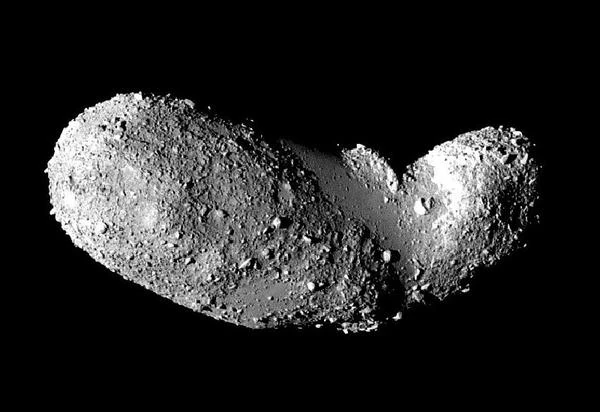
Near-Earth asteroids (NEOs) are celestial bodies whose orbits intersect that of Earth. These objects, remnants of the solar system's formation, represent both a remarkable scientific opportunity and a potential threat to our planet. It is estimated that there are about 25,000 near-Earth asteroids larger than 140 meters in diameter, and nearly a million smaller objects.
Near-Earth asteroids are classified according to their orbital parameters:
The Turin Scale and the Palermo Scale are used to categorize the impact risk of an asteroid. The energy released during an impact depends on the mass and velocity of the object according to the formula: \(E = \frac{1}{2}mv^2\) where \(m\) is the mass and \(v\) is the relative velocity.
For example, a 1 km diameter asteroid traveling at 20 km/s would release enough energy to cause enormous damage on a continental scale.
| Name | Estimated Diameter (m) | Orbital Class | Minimum Distance to Earth (km) | Next Significant Passage | Potential Energy (MT TNT) | Comment |
|---|---|---|---|---|---|---|
| (99942) Apophis | ~340 | Aten | 31,000 | 2029 | ~870 MT | Very close passage, orbit modified by Earth's gravitational interaction |
| (101955) Bennu | ~490 | Apollo | 300,000 | 2135 | ~3,000 MT | Target of the OSIRIS-REx mission, distant impact risk but under intensive monitoring |
| (65803) Didymos | ~780 (binary system) | Apollo | 6,000,000 | 2123 | ~14,000 MT | Target of NASA's DART deflection test and ESA's Hera mission |
| (4179) Toutatis | ~2,500 | Apollo | 1,600,000 | 2004 (last close passage) | ~150,000 MT | Massive object, extensively studied by planetary radar |
| (3200) Phaethon | ~5,100 | Apollo | 10,000,000 | 2093 | ~1,000,000 MT | Parent of the Geminids, highly eccentric orbit |
| 2001 FO32 | ~1,000 | Apollo | 2,000,000 | 2021 (last passage) | ~12,000 MT | Largest known near-Earth asteroid to have recently flown by Earth |
| (3122) Florence | ~4,900 | Apollo | 7,000,000 | 2017 (last passage) | ~850,000 MT | One of the largest known near-Earth asteroids, observed by radar |
| (433) Eros | ~16,800 | Amor | 22,000,000 | 1975 (last passage) | ~25,000,000 MT | First asteroid visited by a probe (NEAR Shoemaker) |
| (1566) Icarus | ~1,400 | Apollo | 6,400,000 | 2015 (last passage) | ~35,000 MT | Asteroid close to the Sun, highly elongated orbit |
| (29075) 1950 DA | ~1,300 | Apollo | 7,500,000 | 2880 | ~30,000 MT | Considered one of the most dangerous in the long term |
| (153814) 2001 WN5 | ~700 | Apollo | 250,000 | 2028 | ~8,000 MT | Next very close passage expected in 2028 |
| (3361) Orpheus | ~300 | Apollo | 2,500,000 | 2021 (last passage) | ~650 MT | Small but closely monitored by radar and optics |
| (162173) Ryugu | ~870 | Apollo | 5,800,000 | 2076 | ~11,000 MT | Target of the Japanese Hayabusa2 mission (sample return) |
| (469219) Kamoʻoalewa | ~40 | Apollo (quasi-satellite) | 3,800,000 | Continuously close | ~0.01 MT | Small object in orbital resonance with Earth |
Sources: NASA – CNEOS Near-Earth Object Program, ESA – Planetary Defence Office,
Potentially Hazardous Asteroids (PHAs) are defined by two criteria: a geocentric Minimum Orbit Intersection Distance (MOID) less than or equal to 0.05 astronomical units (≈ 7.48 × 106 km) and an absolute magnitude \(H\) bright enough to indicate a typical diameter >~140 m (approximately \(H \leq 22\), depending on the assumed albedo). These thresholds are operational and serve to prioritize the monitoring and analysis of impact risks.
The quantification of the actual PHA population combines direct observations and incompleteness models. Optical and infrared observation campaigns (survey surfaces, proper motion detection, photometric and radiometric measurements) provide the observed catalogs.
The values reported in the catalogs evolve with the discovery of smaller objects and the improvement of models. For example (orders of magnitude extracted from catalogs and published estimates):
| Source | Approximate Date | Number of Observed/Estimated PHAs | Remarks |
|---|---|---|---|
| NASA - CNEOS (observed catalog) | 2024–2025 | ~2,400–2,500 observed | Effective catalog, continuously updated |
| Minor Planet Center (IAU) | 2025 | ~2,500 | Consolidated inventory of astronomical discoveries |
| NEOWISE (radiometric estimate) | Recent analyses | ~4,000–5,000 estimated | Correction for incompleteness, sensitive to albedo assumptions |
| Future Projections (Rubin Observatory, NEO Surveyor) | Projections | ~10,000–20,000 (D >~100 m) possible | Based on the increased sensitivity of future detection campaigns |
References and resources: NASA CNEOS, Minor Planet Center (IAU), NEOWISE analyses, and technical documents from the Rubin Observatory and NEO Surveyor programs.